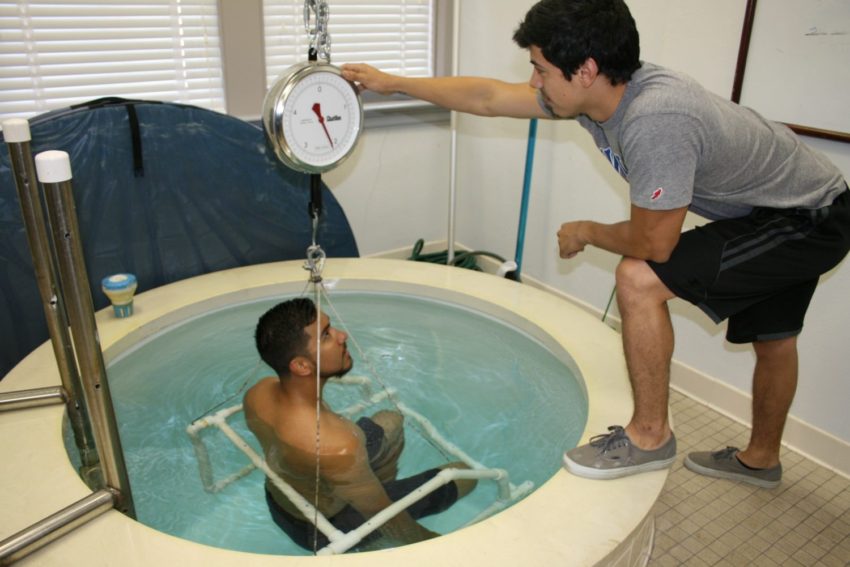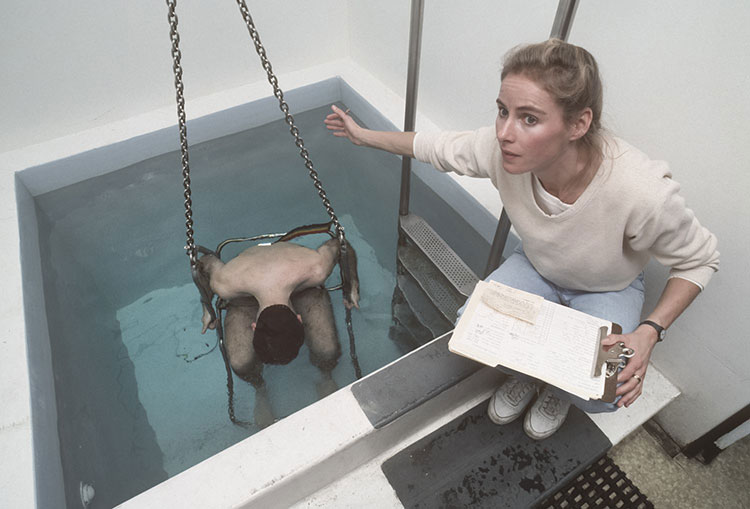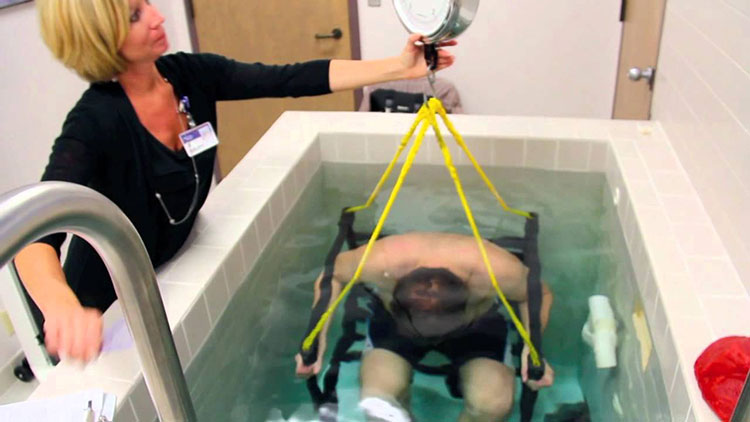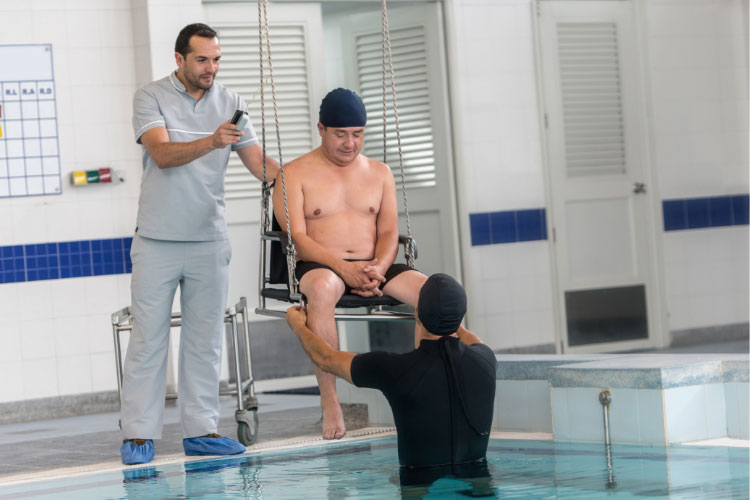Hydrostatic body fat testing is a safe and non-invasive way to assess your body fat percentage and muscle mass. This technique is relatively inexpensive and can be done at many hospitals, universities, and research centers. Below I will address where to get a test done, what it’s like, the cost, and other FAQs. I will also share my experience with the hydrostatic fat testing near me.
Map of Hydrostatic Weighing Near Me
For “Hydrostatic Testing Near Me” or “Hydrostatic Weighing Near Me”, see the map below…
What is Hydrostatic Weighing for Body Composition
A hydrostatic body fat test is a method of determining body composition, or the ratio of fat to lean tissue in the body. This technique is also sometimes called hydrostatic weighing, underwater weighing, or densitometry. It is a common alternative method to DEXA scanning for body composition.
How Does the Hydrostatic Weighing Near Me Work…
Hydrostatic weighing involves immersion in water and the determination of body density. Since fat is less dense than water and muscle is denser than water, the ratio of these two tissues can be determined by measuring body density.
To measure body density, a person is weighed on land first. Then, the person is weighed again while submerged in water. The difference in weight between the two measures is due to the displaced water that is equal to the volume of the person being tested.
The body density of the person being tested is then calculated using the following formulas:
- Body Density = Weight on Land / Weight in Water
- Fat Percentage = (4.536 * Body Density) – 4.5
- Muscle Percentage = 100 – Fat Percentage
Is Hydrostatic Body Fat Testing Accurate?
Hydrostatic weighing is considered to be one of the most accurate methods for determining body fat mass. However, some potential sources of error can affect the accuracy of this technique.
When performed properly, it can be accurate to +/- 1.5% according to NCBI compared to more advanced methods.
For example, the water temperature can affect the density of the body and, as a result, the hydrostatic test results. To account for this, a hydrostatic test is typically done in a temperature-controlled environment.
Additionally, the amount of air that is trapped in the lungs can also affect the results. For this reason, it is important to exhale all the air from the lungs before being weighed underwater.
Finally, it is important to note that hydrostatic fat testing provides an estimate of total body fat mass. It does not give information about the distribution of fat and muscle in the body.
Hydrostatic Weighing vs DEXA Body Composition Scan
Other methods, such as dual-energy X-ray absorptiometry (DXA) can be used to assess the distribution of fat in the body. While the tests both do a great job, there are some pros and cons to each.
In many journals and research papers, hydrostatic weighing is considered more accurate than DEXA for measuring body fat. The other advantage is there is no radiation and it’s often less expensive.
The drawback of hydrostatic weighing when compared to DEXA is that it takes longer, and you need to fully submerge in water, and you don’t get all of the other useful data that a DEXA scan provides. Additionally, it is more difficult to find a facility that does hydrostatic weighing than a DEXA scan.
How to Prepare for Hydrostatic Body Fat Testing
There is no special preparation required for hydrostatic fat testing. However, it is important to wear swimwear or clothing that can get wet.
Additionally, it is important to empty the lungs of air before being submerged in water. This can be done by exhaling fully and then taking a deep breath and holding it until submerging under water.
What to Expect During During The Test
Hydrostatic body fat testing is typically done in a hospital, university, or research setting. The test will be conducted by trained personnel, such as a registered dietitian, exercise physiologist, or nurse.
First, you will be weighed on land. Then, you will be asked to exhale all the air from your lungs and take a deep breath. After taking a deep breath, you will be submerged in water while holding your breath. Some tests involve sitting on a swing scale or seat scale in the water tank.
You will be weighed again while underwater to determine the displaced water weight. The difference in weight between the two measures is due to the displaced water, which is equal to the volume of the person being tested.
Once the displaced water weight has been determined, the body density of the person being tested can be calculated. The body density will then be used to calculate the percentage of fat in the body.
How Long Does the Test Take?
The process of Hydrostatic weighing typically takes about 15 to 30 min to complete measurement. You may be submersed 4 to 5 times to get several measurements.
You should plan to be there for about an hour though. Between getting into your swim gear, getting your initial out-of-water weight submersion, the test itself, drying off, and changing back into dry clothes it’s time-consuming.
How Quickly Do You Get Results?
You will get your results immediately after the test. The percentage of body fat will be calculated and you will be given a printout of your results.
The only situation where you may not get your results immediately is if you were referred by a physician. In that case, the results would be sent to their office and you will need to wait for a call from them. The technician is only there to achieve precise measurement and review the results, but not provide a diagnosis.
How Much Does Hydrostatic Fat Testing Cost?
The cost of hydrostatic body fat testing can vary depending on the facility and geographical location. However, hydrostatic fat testing is typically less expensive than a DEXA scan, which is another method of assessing body fat.
In my experience with the hydrostatic fat testing near me, the first session was $50 and each additional session was $35.
In my experience with hydrostatic weighing near me, for body composition, insurance did not cover the test. An alternative way to pay for it is to use a health savings account (HSA) or a Flexible Savings Account (FSA).
What Are the Benefits of Hydrostatic Weighing?
Hydrostatic body fat testing is a safe and non-invasive way to assess fat mass. This technique can be used to track changes in your body over time, which can be helpful for people who are trying to lose weight or gain muscle mass.
Additionally, this is one of the most accurate methods for determining body composition. This technique can be used to assess the success of weight loss or muscle-building programs. Some consider this the gold standard.
Finally, this type of test is relatively inexpensive, often cheaper than a DEXA scan, and does not require any special equipment.
Are there Any Risks?
There are no risks. The only discomfort you may experience is being wet and cold while you are in the water.
Additionally, it is important to remember this test is an estimate of body composition. It does not give information about the distribution of fat and muscle in the body.
Where to Find Hydrostatic Fat Testing Near Me
If you are interested in hydrostatic testing, there are a few ways to find a facility near you. First, you can check with your local hospital, gym, university, or research center to see if they offer this great service.
Another option is to search online. This can be done by searching for “hydrostatic testing near me” or “body composition testing near me.”
Finally, you can check with your insurance provider to see if they cover the tes. Many insurance providers will cover this service if it is considered medically necessary. For insurance to cover it you will likely need a doctor’s referral.
If you are unable to find a hydrostatic testing center near you, there are other methods to measure fat, such as DEXA scans or skinfold measurements.
Hydrostatic Weighing Near Me – Bottom Line
Hydrostatic body fat testing is a safe, non-invasive, and accurate way to measure body composition. This technique can be used to track changes over time, which can be helpful for people who are trying to lose weight. That’s what I have learned from the facility that does hydrostatic weighing near me.




